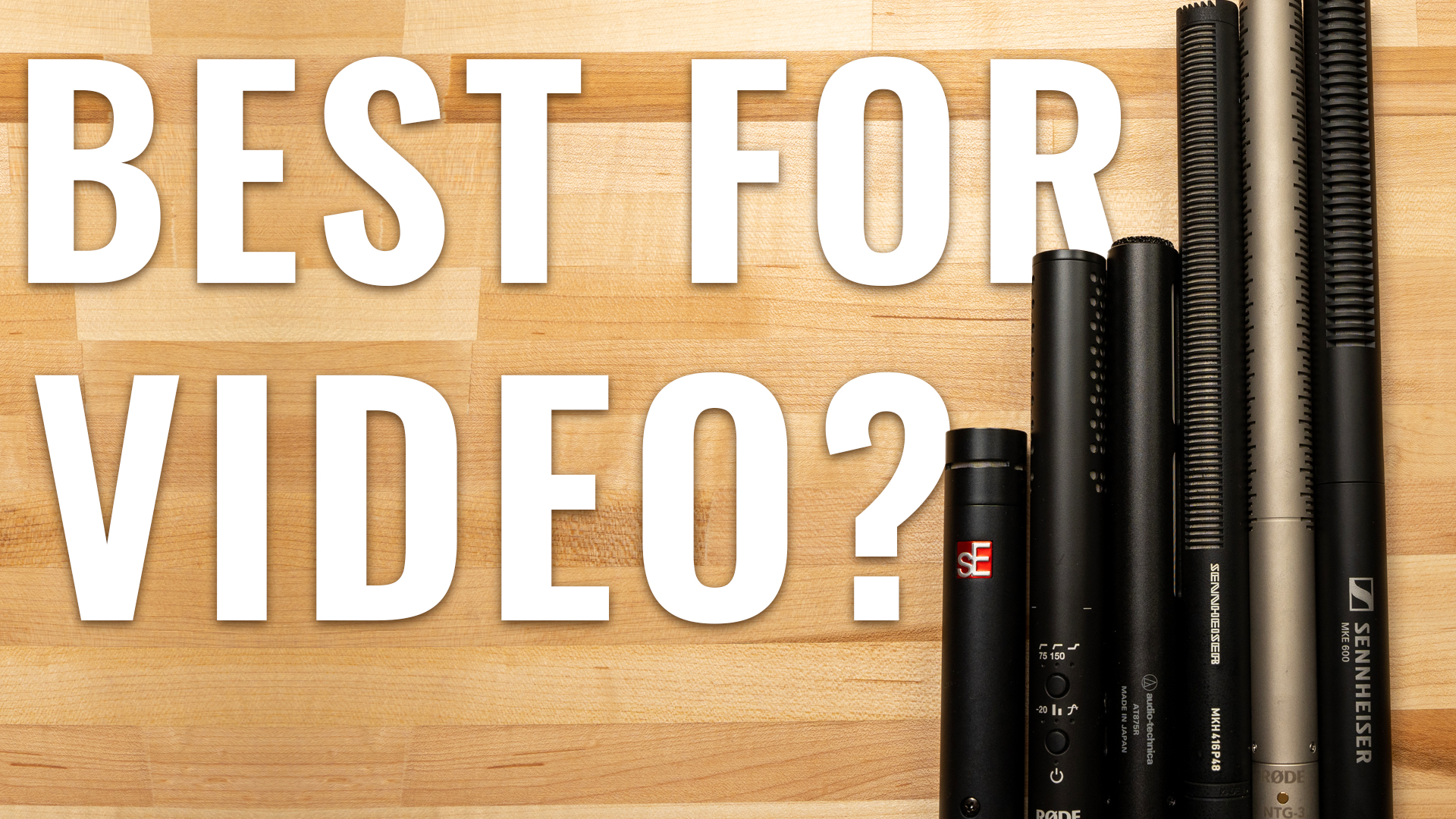Links in this post may be affiliate links. Any products purchased through affiliate links may provide a small commission which helps to support the SemiPro Tech+Gear site and YouTube channel.
If your video content includes talking head shots, product reviews, or interviews, you’ve likely considered getting an overhead boom microphone if you don’t already have one. Setting up a microphone out of frame gives you a nice clean shot and reduces potential clothes-rustling sounds that you might get with a lavalier microphone. But not just any microphone will provide great sound quality when positioned a little bit further away from the subject. Shotgun microphones are the natural first choice, but there is more than one kind and they’re not the only choice for an overhead boom microphone. Below I’ve outlined six of my top choices at different budget levels and you can hear audio samples of each of them in the embedded video!
Best for Untreated Spaces: Sennheiser MKE 600
Best Budget: Audio-Technica AT875R
Best for Flexibility: Rode VideoMic NTG
Best for Musician Content Creators: sE Electronics sE8
1. Audio-Technica AT875R

Price: $169
Polar Pattern: Supercardioid
Freq Response: 90Hz – 20kHz
Power Required: 11v – 52v phantom power
Output: XLR
Features/Switches: None
The AT875R was designed for video dialog, so YouTube-style talking head or product review videos are exactly what it was made for. It fared very well in my comparison test, especially for the price point. Personally I thought it sounded very usable in the test without sound treatment set up, and even better with it. It has a little bit more of a full sound than the sE8 while not being much more harsh in the high end, which may seem odd since the frequency response starts at the highest Hz of any microphone I tested. It does have a touch of harshness in the high frequencies if I listen closely but I don’t find it unpleasant when positioning the mic 8-10 inches from the subject. I liked it so much that I’ve started using it as my regular talking head video mic.
2. Rode VideoMic NTG

Price: $249
Polar Pattern: Supercardioid
Freq Response: 35Hz – 18kHz
Power Required: Built-in Battery or USB power
Output: USB-C / 3.5mm TRS
Features/Switches: HPF, Presence Boost, Pad, Safety Track
The Rode VideoMic NTG is one of the most versatile microphones I’ve used from both content creation and work from home perspectives. The multiple features available through the physical buttons also make it easier to get things right the first time, especially the safety track feature which can record the same mono signal in both the L & R channels, with one of them padded down by 20dB. That means you’ll have usable audio even if part of your main channel clips, saving you from having to re-shoot the whole video or segment. The USB connectivity also makes it a great video call mic if you don’t want to have one on-screen. In my comparison samples, I felt that the VideoMic NTG held up very well against the higher-priced competition when positioned at a distance of about 8-10 inches from the subject (which was the position used in the audio samples). The main difference I’ve found is that at longer distances (12+ inches), it picks up a bit more reflections and room tone than some of the other shotgun microphones in the comparison. All of these mics will sound best when positioned as close as possible to the subject, but it is especially true with the VideoMic NTG.
3. sE Electronics sE8

Price: $259
Polar Pattern: Cardioid
Freq Response: 20Hz – 20kHz
Power Required: 48v
Output: XLR
Features/Switches: HPF, Pad
I used the sE8 for over a year as my primary mic for videos on my POD Insights YouTube channel and loved it. The quality of sound you get for the price makes the sE8 a great value, and if you are also a musician, it’s a terrific mic for acoustic guitar and other instruments. The cardioid polar pattern also makes it a little more forgiving if you tend to move around a bit while recording, compared to a supercardioid or lobar pattern found on shotgun microphones. The main downside that you may hear in the audio samples is that the sE8 will pick up just a little bit more of the room reflections and room tone, which is most noticeable in a space with no sound treatment. Its ability to very clearly pick up transients from acoustic instruments also means it’s good at picking up transient background noise like birds chirping outside your window, so the sE8 is best used in a quiet recording space with at least some sound treatment.
4. Sennheiser MKE 600

Price: $329
Polar Pattern: Cardioid
Freq Response: 40Hz – 20kHz
Power Required: AA Battery or 48v
Output: XLR (3.5mm TRS adapter included)
Features/Switches: HPF
The quality of the audio from the MKE 600 could make it pretty difficult to justify the MKH 416 at 3x the price, especially for content creators looking to level up their audio without a big studio budget. It’s also possible to get the audio of the MKE 600 in your videos without investing in additional gear like a recorder or interface because it comes with an XLR to 3.5mm adapter and can provide its own power via AA battery. This makes it possible to connect directly to your camera, while also giving you the option to use the XLR connection if you already have a recorder or interface or plan on getting one in the future. In my comparison test I thought the MKE 600 had excellent clarity but sounded a little thin with less low-end response, though a little tweak in post should remedy that if you’re looking for a fuller sound. While several of the mics produced a usable recording in the room without sound treatment, when listening closely with headphones I thought the MKE 600 did the best job at minimizing reflections.
5. Rode NTG3

Price: $699
Polar Pattern: Supercardioid
Freq Response: 40Hz – 20kHz
Power Required: 48v
Output: XLR
Features/Switches: None
If you listened to my audio samples in the video above and found some of the microphones hard to tell apart, it likely wasn’t the NTG3. Even though the specs match very closely to the MKH 416 (down to the fairly quiet 13dBA self-noise), Rode gave the NTG3 a significantly different sound profile. The obvious difference is in the fullness of the low end compared to all the other microphones on this list, but I also find it to have a smoother overall sound than most as well. You can safely position the NTG3 a little further away from the subject to control a bit of that low end, and a high pass filter in post doesn’t hurt either. If the NTG3 fits the sound profile you’re looking for, it’s a solid entry in the professional shotgun microphone market. However, another thing the NTG3 has in common with the MKH 416 is that I don’t personally think they’re the best options for content creators. For a YouTuber or content creator just looking to level up their audio, the AT875R, VideoMic NTG, or MKE 600 provide a big step up in audio quality without a huge investment which makes them better options in my opinion.
6. Sennheiser MKH 416

Price: $999
Polar Pattern: Lobar
Freq Response: 40Hz – 20kHz
Power Required: 48v
Output: XLR
Features/Switches: None
I have nothing against the MKH 416. In fact, the reason I own one is because in addition to being a legendary professional shotgun microphone, it’s also a very popular voice over microphone when used at close range. The presence boost is more noticeable at closer range, which gives the sound a quality that “punches through” a mix. This is favorable for commercial voice over that’s going to incorporate music and sound effects in the final project. However I also find that same frequency range to sound rather harsh on the 416, especially if your voice is prone to sibilance. This is a tad less noticeable at a distance, and the 416 is of course a very capable microphone when positioned 8-10 inches from the subject or even 12-15 inches (it also performs very well outdoors). My problem is that when compared to microphones like Sennheiser’s own MKE 600, I just can’t recommend it for content creators, especially small-scale YouTubers. If you have excellent critical listening skills, you will hear a difference. But your audience (or at least the vast majority) does not have the skill or desire to pick apart minute audio differences, and the audio will not sound 3x better to them. So while it has nothing to do with the quality of the MKH 416, it’s not one of my top recommendations for content creators.
There you have it, my top recommendations for overhead microphones for video. There is one additional microphone I’m aware of that is designed for indoor dialog use, the Sennheiser MKH 50. However I did not have one on-hand to test and I did not include it in the list above for the same reason that I do not recommend the MKH 416. It simply is too expensive ($1200) for me to recommend as a top choice for content creators looking to improve audio quality in the early stages of their channel. The MKH 50 absolutely is a terrific choice for talking head videos or interviews, and some YouTubers in the audio/video space use it (Tom Buck and Gerald Undone are two – both channels are totally worth a subscribe if you’re not familiar). It’s the right tool for the job, if your budget allows. But my content is mainly aimed towards newer content creators so I cannot assume or suggest that a $1200 microphone is a smart investment at that stage.
Let me know in the comments what your video mic setup is!


